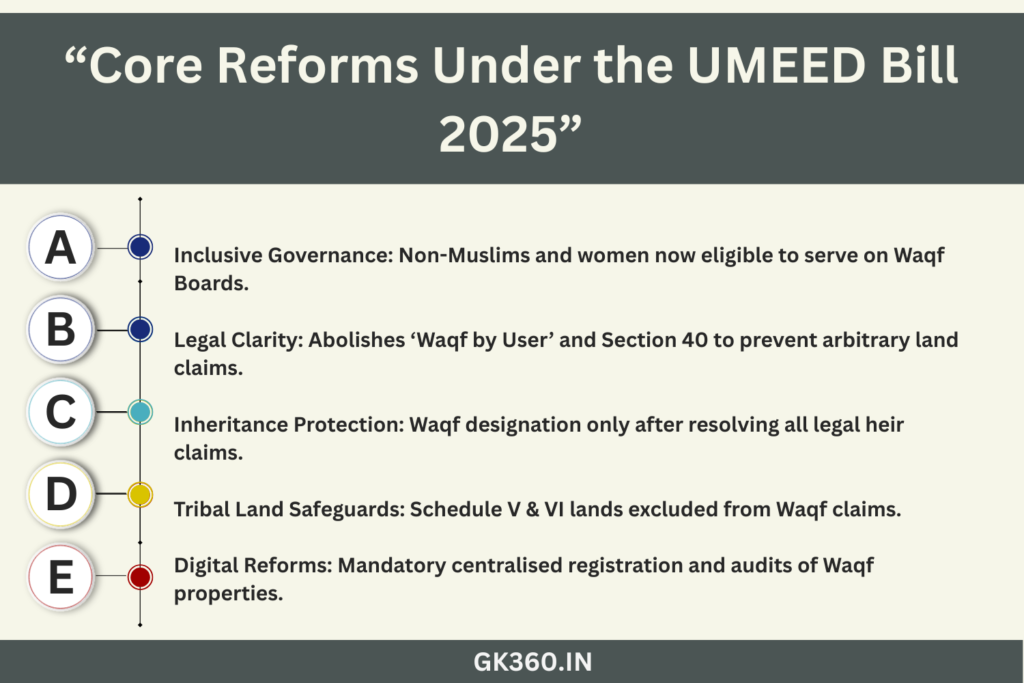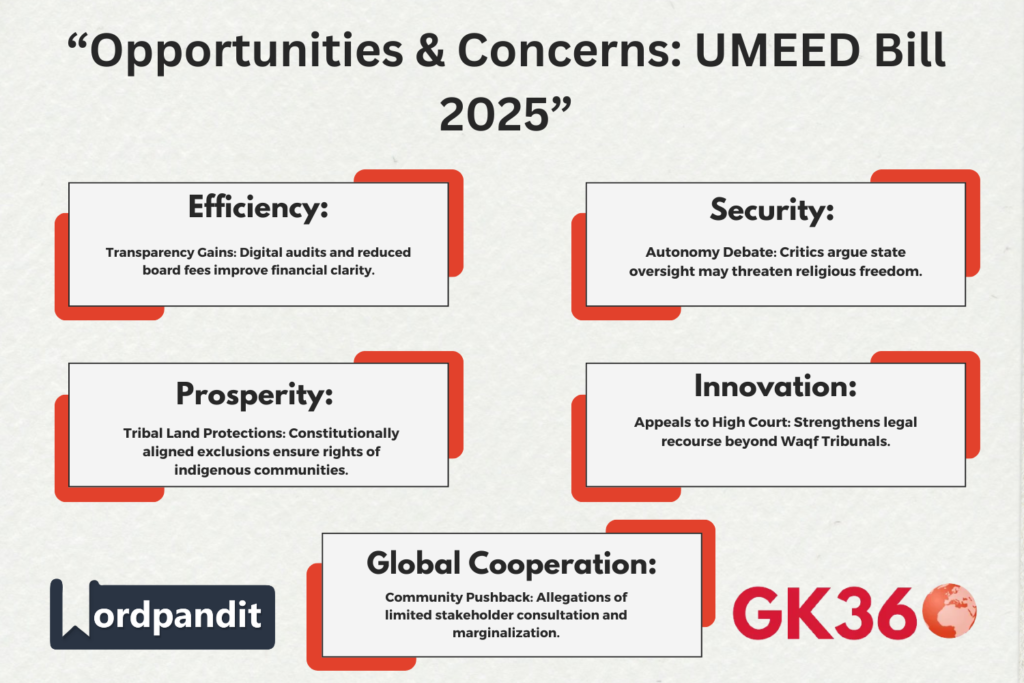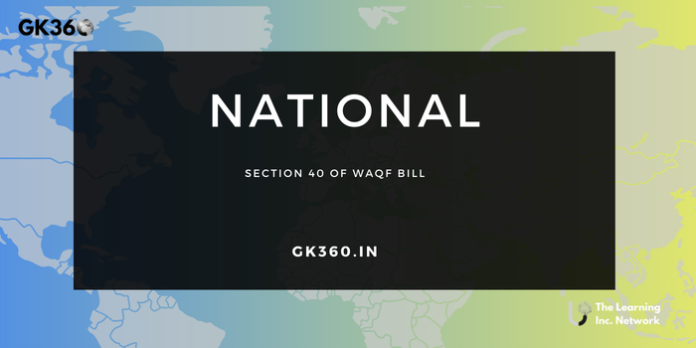Why the Removal of Section 40 of Waqf Bill 2025 is Stirring Controversy
Introduction
The Waqf Amendment Bill 2025, recently tabled in the Lok Sabha, has ignited a nationwide debate over proposed changes to the Waqf Act of 1995—particularly the controversial move to remove Section 40. This section is a cornerstone of the Act, giving the Waqf Board the power to identify and claim properties as Waqf land, even if they are under private or institutional control.
Critics argue that stripping the Waqf Board of this authority could weaken its autonomy, expose Waqf properties to misuse, and shift key decision-making to government officials—raising concerns of potential political interference. The government, on the other hand, claims the amendment will streamline administration and reduce bureaucratic opacity.
This article breaks down what Section 40 entails, why its omission matters, and what implications this holds for Muslim religious endowments in India.

Table of Contents
- What is the Waqf Board and What Does it Do?
- Section 40 Explained: Powers to Determine Waqf Property
- Breakdown: Key Clauses Under Section 40
- Why is the Government Removing Section 40?
- Criticism and Concerns: What Experts Are Saying
- Impact on the Waqf Board’s Autonomy and Property Disputes
- Legal and Political Implications of the 2025 Waqf Amendment
- FAQs About Section 40 and the Waqf Act
- Conclusion: The Road Ahead for Waqf Governance in India
What is the Waqf Board and What Does it Do?
The Waqf Board is a statutory body established under the Waqf Act, 1995, tasked with overseeing and managing Waqf properties—land and assets donated by individuals for religious or charitable purposes in Islam. These may include mosques, graveyards, schools, and hospitals, among other charitable institutions.
Each state in India has its own Waqf Board, while the Central Waqf Council supervises and coordinates at the national level. The Board’s primary responsibilities include:
- Maintaining records of Waqf properties
- Ensuring the properties are used per donor intent
- Settling disputes and initiating legal proceedings where needed
- Preventing illegal occupation or mismanagement of Waqf assets
The Waqf Board serves as a guardian of community assets, and Section 40 historically served as one of its most powerful legal tools.
Section 40 Explained: Powers to Determine Waqf Property
Section 40 of the Waqf Act granted the Waqf Board the authority to declare any property as Waqf after due inquiry. This empowered the Board to proactively investigate and assess if land or property—though not officially registered as Waqf—met the criteria for religious endowment.
Here’s why Section 40 mattered:
- It allowed the Board to initiate suo motu inquiries (on its own accord).
- It served as a mechanism to reclaim wrongly held or unrecognized Waqf land.
- Its final determination could only be challenged before a Waqf Tribunal, ensuring limited political interference.
With this provision, the Waqf Board had quasi-judicial powers to preserve and protect properties that could otherwise be lost to private or unauthorized control.
Breakdown: Key Clauses Under Section 40
Section 40 was composed of four essential parts, each designed to secure the integrity of Waqf properties:
- Information Gathering & Inquiry
The Board had the right to collect data about any property suspected to be Waqf and conduct investigations. - Final Decision Authority
Once the Board made a determination, it could not be overruled by any executive or administrative authority, except through a Waqf Tribunal. - Cross-Registered Property Review
If a property was under a different trust or registered society but had characteristics of Waqf, the Board could issue a notice and demand re-registration under the Waqf Act. - Right to Adjudicate
Upon receiving a response, the Board could still finalize its decision—only contestable via a judicial route, not administrative channels.
Why is the Government Removing Section 40?
The Central Government has justified the removal of Section 40 in the Waqf Amendment Bill 2025 on the grounds of improving transparency and administrative efficiency. Officials argue that:
- Section 40 concentrates too much power in the hands of the Waqf Board, allowing it to declare properties as Waqf without broader scrutiny.
- It creates bureaucratic delays in property administration due to overlapping claims and the time-consuming inquiry process.
- The amendment will help prevent legal ambiguities, improve property utilization, and bring more accountability to the system.
According to the Ministry of Minority Affairs, the goal is not to weaken the Board but to clarify and streamline governance of religious endowment properties.
Criticism and Concerns: What Experts Are Saying
Despite the government’s assurances, legal experts, activists, and opposition leaders have voiced significant concerns:
- Erosion of Autonomy: Section 40 gave the Waqf Board an independent mechanism to protect religious properties. Its removal risks centralizing control with state machinery.
- Political Misuse Risk: Without Section 40, determinations about Waqf property could fall to bureaucrats or land departments—raising fears of political manipulation or land grabs.
- Impact on Marginalized Communities: Many Waqf properties support education, healthcare, and welfare programs for underprivileged Muslims. Weakening protections could affect these services.
Several critics have called for judicial review of the amendment or at least a revised version that balances governance reforms with the preservation of institutional independence.
Impact on the Waqf Board’s Autonomy and Property Disputes
Removing Section 40 could dramatically shift how Waqf property disputes are identified and resolved:
| Aspect | With Section 40 | Without Section 40 |
|---|---|---|
| 🏷️ Authority to Declare Waqf | Waqf Board (via inquiry) | Possibly with revenue or land department |
| 📋 Appeal Process | Through Waqf Tribunal | Possibly through civil courts |
| 🚧 Protection from Encroachment | Proactive investigation | More reactive, dependent on litigation |
| 🔐 Autonomy Level | High | Reduced |
This change may open the door to more litigation, delay dispute resolution, and limit the Waqf Board’s role as a guardian of religious assets.
Legal and Political Implications of the 2025 Waqf Amendment
The political implications are far-reaching. The opposition claims this amendment is part of a broader agenda to dilute minority institutions, while the ruling government frames it as a step toward modernizing archaic laws.
Legal analysts suggest the following may occur:
- Increased cases in Waqf Tribunals and civil courts
- Potential constitutional challenges citing infringement of religious rights under Article 26
- Calls for policy safeguards or alternate dispute resolution mechanisms to compensate for the loss of Section 40
The amendment is likely to feature prominently in public discourse, legal forums, and possibly upcoming elections, as it touches on property rights, religious freedom, and governance ethics.

FAQs About Section 40 and the Waqf Act
- What was the purpose of Section 40 in the Waqf Act?
Section 40 empowered the Waqf Board to determine whether a property qualifies as Waqf through inquiries and fact-finding. It allowed for independent protection of religious endowments. - Why is the removal of Section 40 controversial?
Critics argue it limits the Waqf Board’s authority, increases government control over religious property, and may lead to misuse or encroachment. - What are Waqf properties used for?
Waqf properties are meant for religious, educational, and charitable purposes in Islam—like building mosques, schools, orphanages, and community centers. - Who can challenge the Waqf Board’s decisions under Section 40?
Only the Waqf Tribunal can overturn a Board’s decision, which limits interference from political or executive authorities. - Does the amendment affect existing Waqf properties?
The amendment mainly affects future disputes and declarations. Existing registered Waqf properties may remain protected but could face challenges in case of legal conflict.
Conclusion: The Road Ahead for Waqf Governance in India
The removal of Section 40 from the Waqf Act marks a turning point in how India manages and protects religious endowments. While the government claims it will improve efficiency, the decision has sparked concerns about transparency, minority rights, and institutional independence.
As the debate continues, the future of Waqf governance in India will depend on whether alternative mechanisms can be implemented to protect these sacred and charitable properties. A balance must be struck between reform and preserving the intent and legacy of religious endowments.
Key Takeaways Table
| Aspect | Details |
| Bill Name | UMEED Bill (Unified Management Empowerment Efficiency and Development) |
| Passed On | April 2, 2025 in Lok Sabha |
| Core Objectives | Transparency, digital governance, legal clarity, inclusive representation |
| Major Reforms | Abolishment of ‘Waqf by User’, Section 40, digital registration, tribal protections |
| Board Composition | Inclusion of non-Muslims and women in Central & State Waqf Boards |
| Legal Enhancements | Right to appeal to High Court, dispute resolution by senior officers |
| Criticisms Raised | Threat to religious autonomy, inadequate stakeholder consultation, reduced tribunal authority |
🔍 Stay updated on key policy changes and legal insights affecting minority communities on GK360.in.





